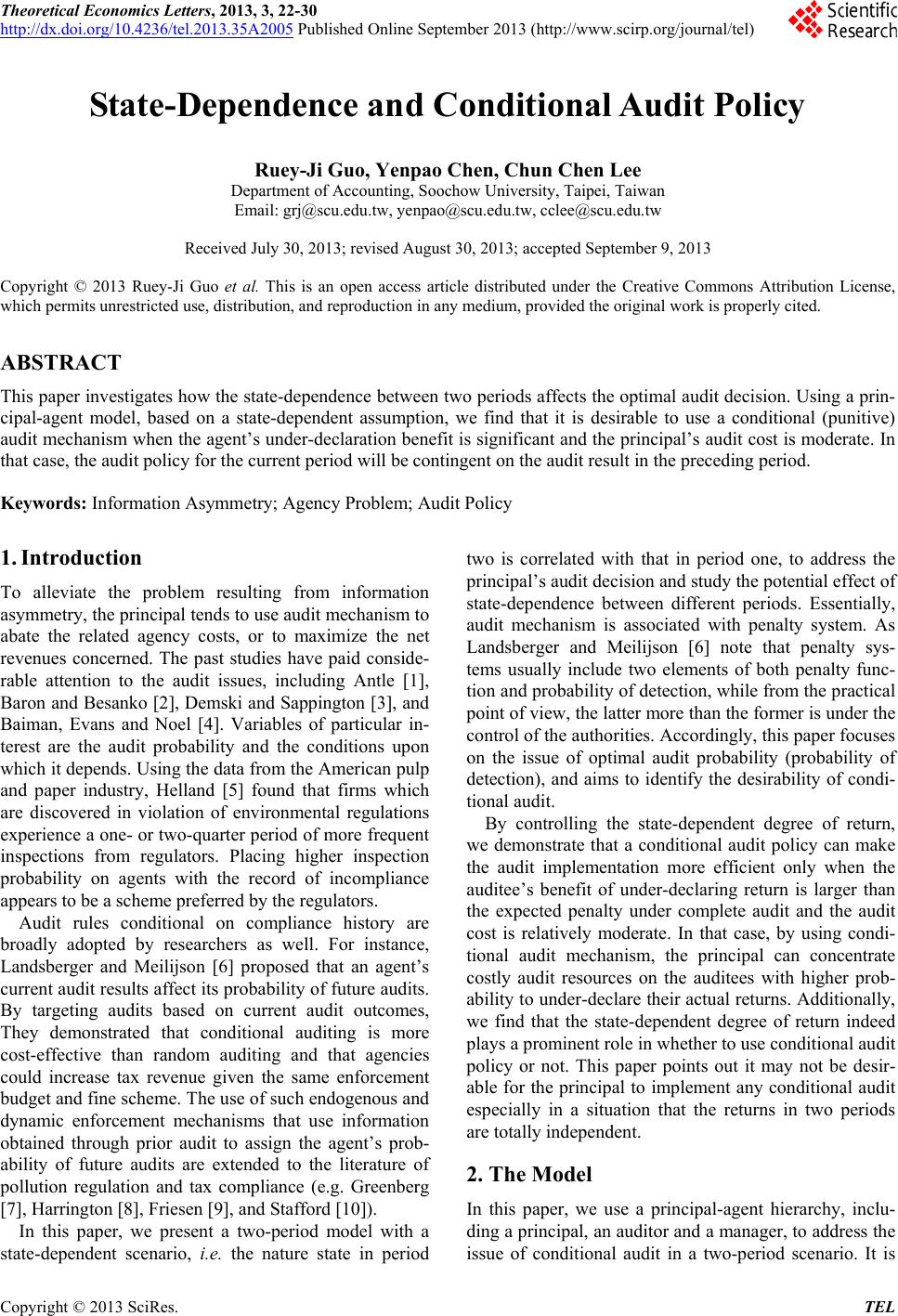 Theoretical Economics Letters, 2013, 3, 22-30 http://dx.doi.org/10.4236/tel.2013.35A2005 Published Online September 2013 (http://www.scirp.org/journal/tel) State-Dependence and Conditional Audit Policy Ruey-Ji Guo, Yenpao Chen, Chun Chen Lee Department of Accounting, Soochow University, Taipei, Taiwan Email: grj@scu.edu.tw, yenpao@scu.edu.tw, cclee@scu.edu.tw Received July 30, 2013; revised August 30, 2013; accepted September 9, 2013 Copyright © 2013 Ruey-Ji Guo et al. This is an open access article distributed under the Creative Commons Attribution License, which permits unrestricted use, distribution, and reproduction in any medium, provided the original work is properly cited. ABSTRACT This paper investigates how the state-dependence between two periods affects the optimal audit decision. Using a prin- cipal-agent model, based on a state-dependent assumption, we find that it is desirable to use a conditional (punitive) audit mechanism when the agent’s under-declaration benefit is significant and the principal’s audit cost is moderate. In that case, the audit policy for the current period will be contingent on the audit result in the preceding period. Keywords: Information Asymmetry; Agency Problem; Audit Policy 1. Introduction To alleviate the problem resulting from information asymmetry, the principal tends to use audit mechanism to abate the related agency costs, or to maximize the net revenues concerned. The past studies have paid conside- rable attention to the audit issues, including Antle [1], Baron and Besanko [2], Demski and Sappington [3], and Baiman, Evans and Noel [4]. Variables of particular in- terest are the audit probability and the conditions upon which it depends. Using the data from the American pulp and paper industry, Helland [5] found that firms which are discovered in violation of environmental regulations experience a one- or two-quarter period of more frequent inspections from regulators. Placing higher inspection probability on agents with the record of incompliance appears to be a scheme preferred by the regulators. Audit rules conditional on compliance history are broadly adopted by researchers as well. For instance, Landsberger and Meilijson [6] proposed that an agent’s current audit results affect its probability of future audits. By targeting audits based on current audit outcomes, They demonstrated that conditional auditing is more cost-effective than random auditing and that agencies could increase tax revenue given the same enforcement budget and fine scheme. The use of such endogenous and dynamic enforcement mechanisms that use information obtained through prior audit to assign the agent’s prob- ability of future audits are extended to the literature of pollution regulation and tax compliance (e.g. Greenberg [7], Harrington [8], Friesen [9], and Stafford [10]). In this paper, we present a two-period model with a state-dependent scenario, i.e. the nature state in period two is correlated with that in period one, to address the principal’s audit decision and study the potential effect of state-dependence between different periods. Essentially, audit mechanism is associated with penalty system. As Landsberger and Meilijson [6] note that penalty sys- tems usually include two elements of both penalty func- tion and probability of detection, while from the practical point of view, the latter more than the former is under the control of the authorities. Accordingly, this paper focuses on the issue of optimal audit probability (probability of detection), and aims to identify the desirability of condi- tional audit. By controlling the state-dependent degree of return, we demonstrate that a conditional audit policy can make the audit implementation more efficient only when the auditee’s benefit of under-declaring return is larger than the expected penalty under complete audit and the audit cost is relatively moderate. In that case, by using condi- tional audit mechanism, the principal can concentrate costly audit resources on the auditees with higher prob- ability to under-declare their actual returns. Additionally, we find that the state-dependent degree of return indeed plays a prominent role in whether to use conditional audit policy or not. This paper points out it may not be desir- able for the principal to implement any conditional audit especially in a situation that the returns in two periods are totally independent. 2. The Model In this paper, we use a principal-agent hierarchy, inclu- ding a principal, an auditor and a manager, to address the issue of conditional audit in a two-period scenario. It is C opyright © 2013 SciRes. TEL 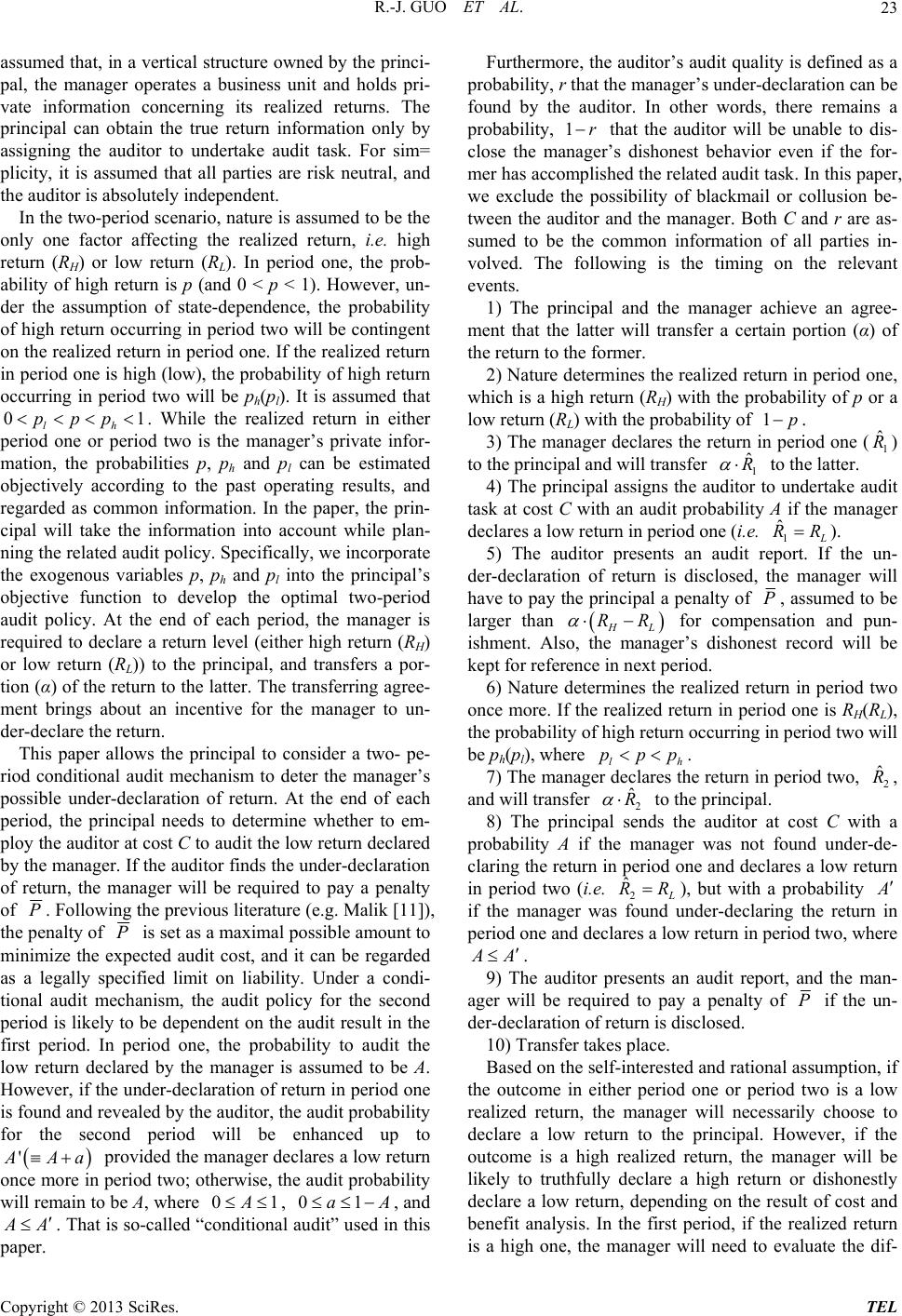 R.-J. GUO ET AL. 23 assumed that, in a vertical structure owned by the princi- pal, the manager operates a business unit and holds pri- vate information concerning its realized returns. The principal can obtain the true return information only by assigning the auditor to undertake audit task. For sim= plicity, it is assumed that all parties are risk neutral, and the auditor is absolutely independent. In the two-period scenario, nature is assumed to be the only one factor affecting the realized return, i.e. high return (RH) or low return (RL). In period one, the prob- ability of high return is p (and 0 < p < 1). However, un- der the assumption of state-dependence, the probability of high return occurring in period two will be contingent on the realized return in period one. If the realized return in period one is high (low), the probability of high return occurring in period two will be ph(pl). It is assumed that . While the realized return in either period one or period two is the manager’s private infor- mation, the probabilities p, ph and pl can be estimated objectively according to the past operating results, and regarded as common information. In the paper, the prin- cipal will take the information into account while plan- ning the related audit policy. Specifically, we incorporate the exogenous variables p, ph and pl into the principal’s objective function to develop the optimal two-period audit policy. At the end of each period, the manager is required to declare a return level (either high return (RH) or low return (RL)) to the principal, and transfers a por- tion (α) of the return to the latter. The transferring agree- ment brings about an incentive for the manager to un- der-declare the return. 0 lh ppp1 This paper allows the principal to consider a two- pe- riod conditional audit mechanism to deter the manager’s possible under-declaration of return. At the end of each period, the principal needs to determine whether to em- ploy the auditor at cost C to audit the low return declared by the manager. If the auditor finds the under-declaration of return, the manager will be required to pay a penalty of . Following the previous literature (e.g. Malik [11]), the penalty of is set as a maximal possible amount to minimize the expected audit cost, and it can be regarded as a legally specified limit on liability. Under a condi- tional audit mechanism, the audit policy for the second period is likely to be dependent on the audit result in the first period. In period one, the probability to audit the low return declared by the manager is assumed to be A. However, if the under-declaration of return in period one is found and revealed by the auditor, the audit probability for the second period will be enhanced up to ' Furthermore, the auditor’s audit quality is defined as a probability, r that the manager’s under-declaration can be found by the auditor. In other words, there remains a probability, 1r that the auditor will be unable to dis- close the manager’s dishonest behavior even if the for- mer has accomplished the related audit task. In this paper, we exclude the possibility of blackmail or collusion be- tween the auditor and the manager. Both C and r are as- sumed to be the common information of all parties in- volved. The following is the timing on the relevant events. 1) The principal and the manager achieve an agree- ment that the latter will transfer a certain portion (α) of the return to the former. 2) Nature determines the realized return in period one, which is a high return (RH) with the probability of p or a low return (RL) with the probability of . 1p 3) The manager declares the return in period one () to the principal and will transfer to the latter. 1 ˆ R 1 4) The principal assigns the auditor to undertake audit task at cost C with an audit probability A if the manager declares a low return in period one (i.e. ˆ R 1 ˆ RR). 5) The auditor presents an audit report. If the un- der-declaration of return is disclosed, the manager will have to pay the principal a penalty of P, assumed to be larger than L RR for compensation and pun- ishment. Also, the manager’s dishonest record will be kept for reference in next period. 6) Nature determines the realized return in period two once more. If the realized return in period one is RH(RL), the probability of high return occurring in period two will be ph(pl), where lh ppp . 7) The manager declares the return in period two, , and will transfer 2 ˆ R 2 ˆ R to the principal. 8) The principal sends the auditor at cost C with a probability A if the manager was not found under-de- claring the return in period one and declares a low return in period two (i.e. 2 ˆ RR), but with a probability if the manager was found under-declaring the return in period one and declares a low return in period two, where A . 9) The auditor presents an audit report, and the man- ager will be required to pay a penalty of P if the un- der-declaration of return is disclosed. 10) Transfer takes place. Based on the self-interested and rational assumption, if the outcome in either period one or period two is a low realized return, the manager will necessarily choose to declare a low return to the principal. However, if the outcome is a high realized return, the manager will be likely to truthfully declare a high return or dishonestly declare a low return, depending on the result of cost and benefit analysis. In the first period, if the realized return is a high one, the manager will need to evaluate the dif- Aa provided the manager declares a low return once more in period two; otherwise, the audit probability will remain to be A, where 01A , , and 01aA A . That is so-called “conditional audit” used in this paper. Copyright © 2013 SciRes. TEL 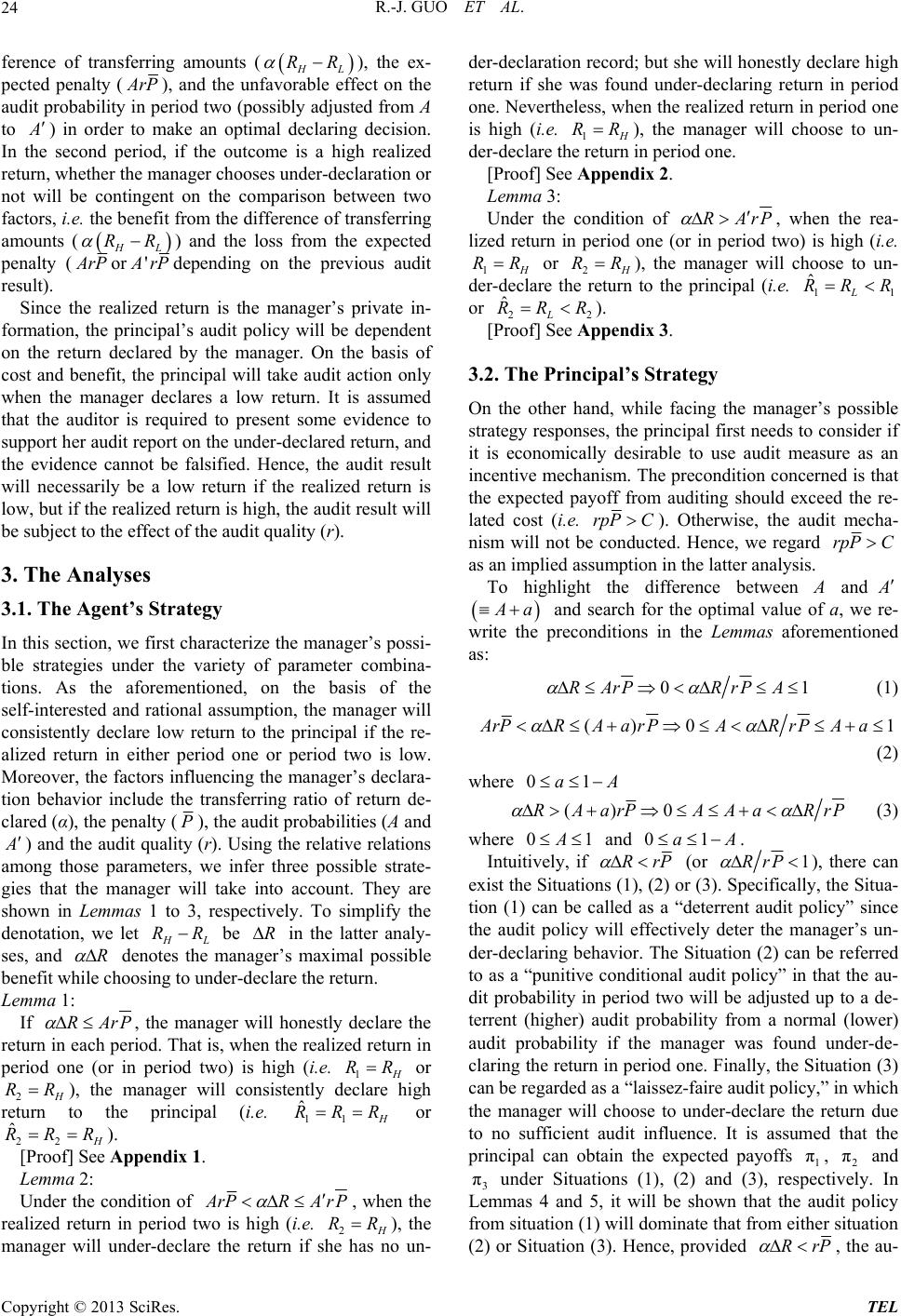 R.-J. GUO ET AL. 24 ference of transferring amounts ( L RR ), the ex- pected penalty ( rP ), and the unfavorable effect on the audit probability in period two (possibly adjusted from A to ) in order to make an optimal declaring decision. In the second period, if the outcome is a high realized return, whether the manager chooses under-declaration or not will be contingent on the comparison between two factors, i.e. the benefit from the difference of transferring amounts ( L RR ) and the loss from the expected penalty ( rP or ' rP depending on the previous audit result). Since the realized return is the manager’s private in- formation, the principal’s audit policy will be dependent on the return declared by the manager. On the basis of cost and benefit, the principal will take audit action only when the manager declares a low return. It is assumed that the auditor is required to present some evidence to support her audit report on the under-declared return, and the evidence cannot be falsified. Hence, the audit result will necessarily be a low return if the realized return is low, but if the realized return is high, the audit result will be subject to the effect of the audit quality (r). 3. The Analyses 3.1. The Agent’s Strategy In this section, we first characterize the manager’s possi- ble strategies under the variety of parameter combina- tions. As the aforementioned, on the basis of the self-interested and rational assumption, the manager will consistently declare low return to the principal if the re- alized return in either period one or period two is low. Moreover, the factors influencing the manager’s declara- tion behavior include the transferring ratio of return de- clared (α), the penalty (P), the audit probabilities (A and ) and the audit quality (r). Using the relative relations among those parameters, we infer three possible strate- gies that the manager will take into account. They are shown in Lemmas 1 to 3, respectively. To simplify the denotation, we let L be in the latter analy- ses, and RRR R denotes the manager’s maximal possible benefit while choosing to under-declare the return. Lemma 1: If RArP , the manager will honestly declare the return in each period. That is, when the realized return in period one (or in period two) is high (i.e. 1 RR or 2 RR), the manager will consistently declare high return to the principal (i.e. 11 ˆ RRR or 22 ˆ RRR). [Proof] See Appendix 1. Lemma 2: Under the condition of rPRArP , when the realized return in period two is high (i.e. 2 RR), the manager will under-declare the return if she has no un- der-declaration record; but she will honestly declare high return if she was found under-declaring return in period one. Nevertheless, when the realized return in period one is high (i.e. 1 RR ), the manager will choose to un- der-declare the return in period one. [Proof] See Appendix 2. Lemma 3: Under the condition of RArP , when the rea- lized return in period one (or in period two) is high (i.e. 1 RR or 2 RR ), the manager will choose to un- der-declare the return to the principal (i.e. 11 ˆL RR R or 22L ˆ RRR ). [Proof] See Appendix 3. 3.2. The Principal’s Strategy On the other hand, while facing the manager’s possible strategy responses, the principal first needs to consider if it is economically desirable to use audit measure as an incentive mechanism. The precondition concerned is that the expected payoff from auditing should exceed the re- lated cost (i.e. rpP C). Otherwise, the audit mecha- nism will not be conducted. Hence, we regard rpP C as an implied assumption in the latter analysis. To highlight the difference between A and a and search for the optimal value of a, we re- write the preconditions in the Lemmas aforementioned as: 01RArP RrPA (1) () 0ArPRAar PARr PAa 1 (2) where 01aA () 0RAarPAAa RrP (3) where 0A1 and 01aA . Intuitively, if RrP (or 1RrP ), there can exist the Situations (1), (2) or (3). Specifically, the Situa- tion (1) can be called as a “deterrent audit policy” since the audit policy will effectively deter the manager’s un- der-declaring behavior. The Situation (2) can be referred to as a “punitive conditional audit policy” in that the au- dit probability in period two will be adjusted up to a de- terrent (higher) audit probability from a normal (lower) audit probability if the manager was found under-de- claring the return in period one. Finally, the Situation (3) can be regarded as a “laissez-faire audit policy,” in which the manager will choose to under-declare the return due to no sufficient audit influence. It is assumed that the principal can obtain the expected payoffs 1, 2 and 3 under Situations (1), (2) and (3), respectively. In Lemmas 4 and 5, it will be shown that the audit policy from situation (1) will dominate that from either situation (2) or Situation (3). Hence, provided π π π RrP , the au- Copyright © 2013 SciRes. TEL 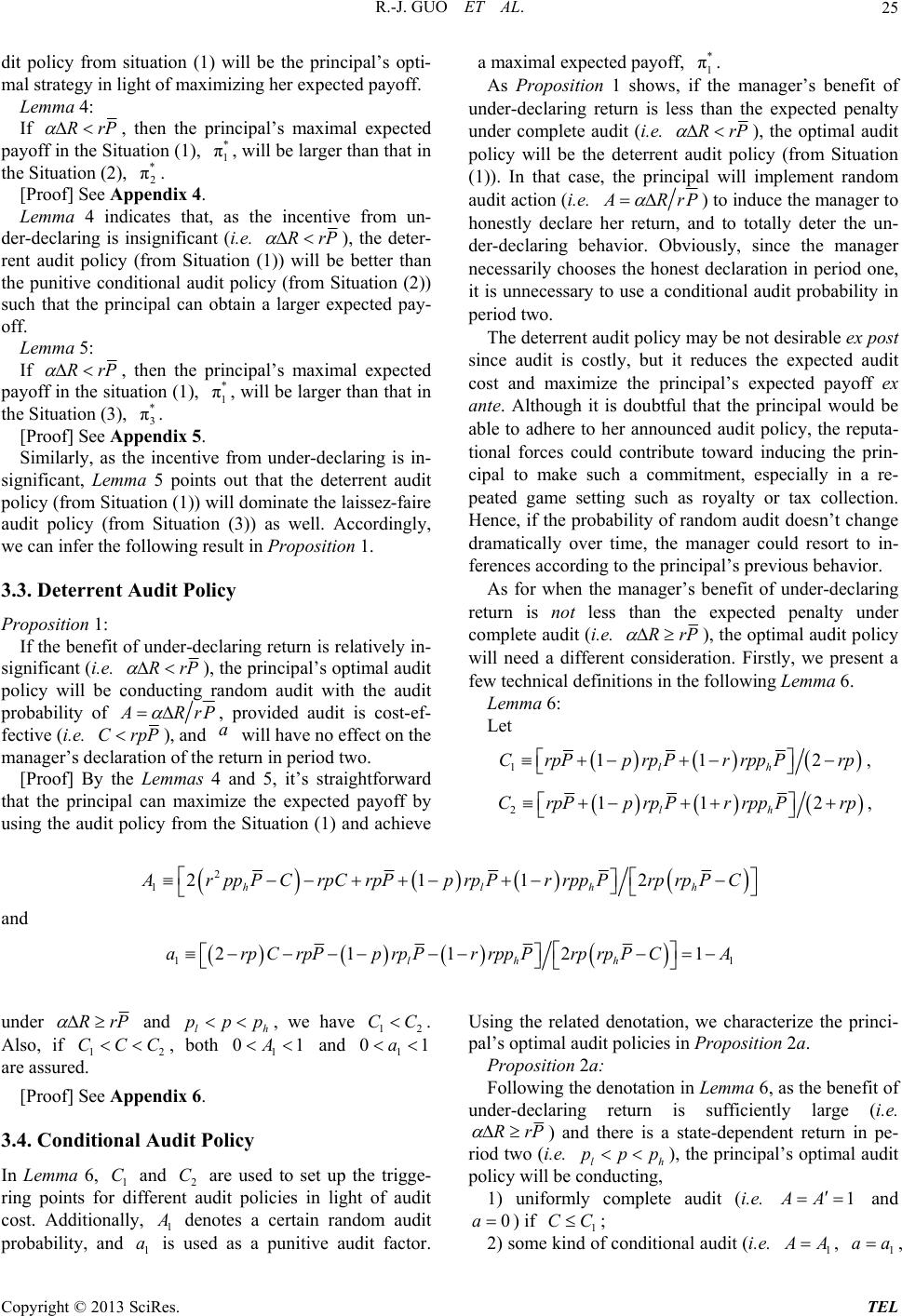 R.-J. GUO ET AL. Copyright © 2013 SciRes. TEL 25 a maximal expected payoff, . * 1 π dit policy from situation (1) will be the principal’s opti- mal strategy in light of maximizing her expected payoff. As Proposition 1 shows, if the manager’s benefit of under-declaring return is less than the expected penalty under complete audit (i.e. RrP ), the optimal audit policy will be the deterrent audit policy (from Situation (1)). In that case, the principal will implement random audit action (i.e. RrP ) to induce the manager to honestly declare her return, and to totally deter the un- der-declaring behavior. Obviously, since the manager necessarily chooses the honest declaration in period one, it is unnecessary to use a conditional audit probability in period two. Lemma 4: If RrP , then the principal’s maximal expected payoff in the Situation (1), , will be larger than that in the Situation (2), . * 1 π * 2 π [Proof] See Appendix 4. Lemma 4 indicates that, as the incentive from un- der-declaring is insignificant (i.e. RrP ), the deter- rent audit policy (from Situation (1)) will be better than the punitive conditional audit policy (from Situation (2)) such that the principal can obtain a larger expected pay- off. The deterrent audit policy may be not desirable ex post since audit is costly, but it reduces the expected audit cost and maximize the principal’s expected payoff ex ante. Although it is doubtful that the principal would be able to adhere to her announced audit policy, the reputa- tional forces could contribute toward inducing the prin- cipal to make such a commitment, especially in a re- peated game setting such as royalty or tax collection. Hence, if the probability of random audit doesn’t change dramatically over time, the manager could resort to in- ferences according to the principal’s previous behavior. Lemma 5: If RrP , then the principal’s maximal expected payoff in the situation (1), , will be larger than that in the Situation (3), . * 1 π * 3 π [Proof] See Appendix 5. Similarly, as the incentive from under-declaring is in- significant, Lemma 5 points out that the deterrent audit policy (from Situation (1)) will dominate the laissez-faire audit policy (from Situation (3)) as well. Accordingly, we can infer the following result in Proposition 1. 3.3. Deterrent Audit Policy As for when the manager’s benefit of under-declaring return is not less than the expected penalty under complete audit (i.e. RrP ), the optimal audit policy will need a different consideration. Firstly, we present a few technical definitions in the following Lemma 6. Proposition 1: If the benefit of under-declaring return is relatively in- significant (i.e. RrP ), the principal’s optimal audit policy will be conducting random audit with the audit probability of RrP , provided audit is cost-ef- fective (i.e. CrpP), and will have no effect on the manager’s declaration of the return in period two. a Lemma 6: Let 111 2 lh CrpPprpP rrppPrp , [Proof] By the Lemmas 4 and 5, it’s straightforward that the principal can maximize the expected payoff by using the audit policy from the Situation (1) and achieve 211 2 lh CrpPprpP rrppPrp , 2 12112 hlhh rpp PCrpCrpPprpPrrpp Prprp PC and 1 1 2112 lhh arpCrpPprpPrrppPrprpPCA 1 under RrP and l, we have h ppp 12 CC . Also, if 1 CC , both and 21 0AC 111 0a are assured. Using the related denotation, we characterize the princi- pal’s optimal audit policies in Proposition 2a. Proposition 2a: Following the denotation in Lemma 6, as the benefit of under-declaring return is sufficiently large (i.e. RrP ) and there is a state-dependent return in pe- riod two (i.e. lh ppp ), the principal’s optimal audit policy will be conducting, [Proof] See Appendix 6. 3.4. Conditional Audit Policy In Lemma 6, 1 and 2 C are used to set up the trigge- ring points for different audit policies in light of audit cost. Additionally, 1 C denotes a certain random audit probability, and is used as a punitive audit factor. 1 a 1) uniformly complete audit (i.e. 1 A and 0a ) if 1 CC ; 2) some kind of conditional audit (i.e. 1 A, 1 aa , 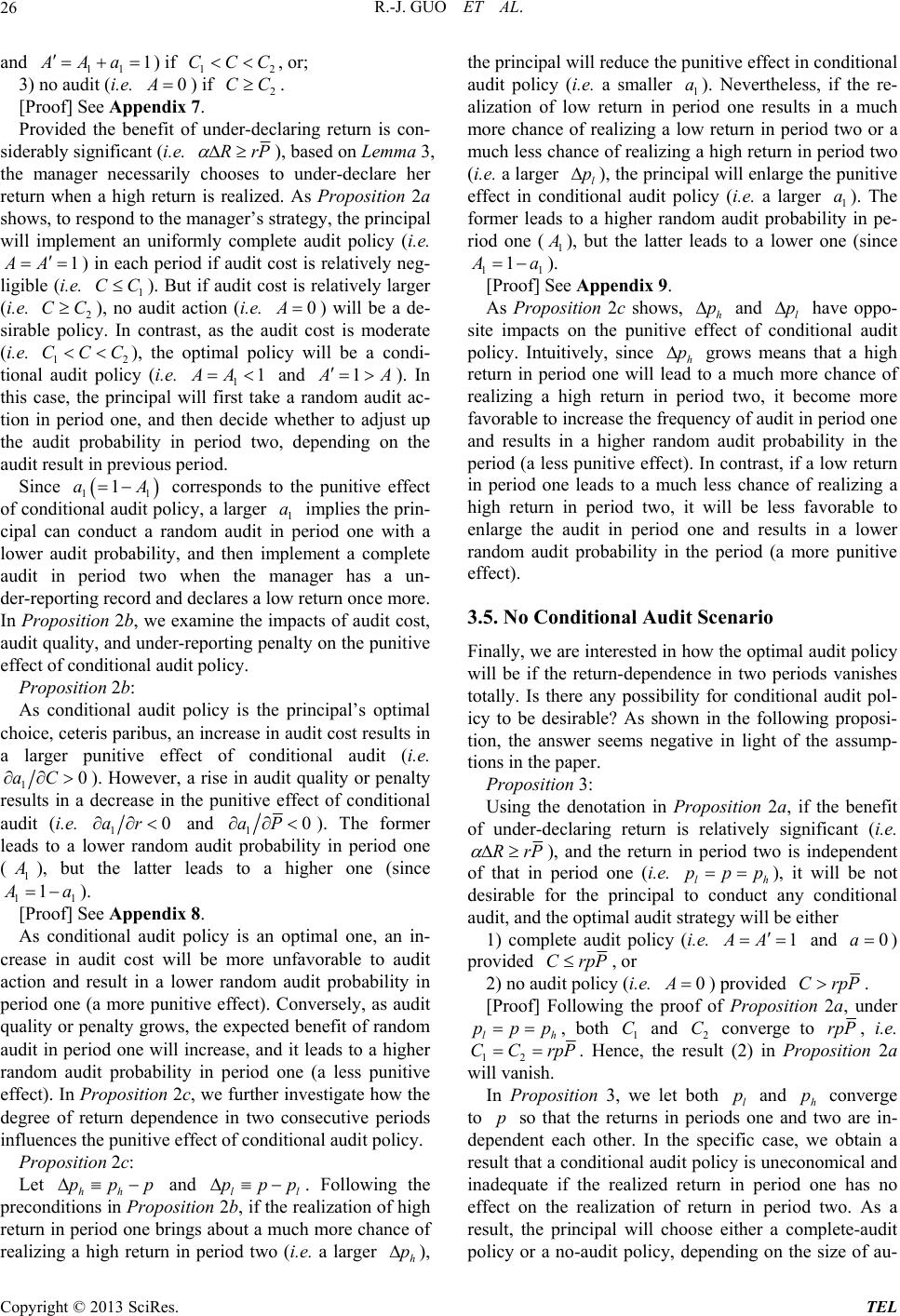 R.-J. GUO ET AL. 26 and ) if , or; 11 12 3) no audit (i.e. ) if . 1AAa A CCC 02 CC [Proof] See Appendix 7. Provided the benefit of under-declaring return is con- siderably significant (i.e. RrP ), based on Lemma 3, the manager necessarily chooses to under-declare her return when a high return is realized. As Proposition 2a shows, to respond to the manager’s strategy, the principal will implement an uniformly complete audit policy (i.e. 1 A CC CC CCC ) in each period if audit cost is relatively neg- ligible (i.e. 1). But if audit cost is relatively larger (i.e. 2), no audit action (i.e. ) will be a de- sirable policy. In contrast, as the audit cost is moderate (i.e. 12 ), the optimal policy will be a condi- tional audit policy (i.e. 1 and 0A 1AA 1 A ). In this case, the principal will first take a random audit ac- tion in period one, and then decide whether to adjust up the audit probability in period two, depending on the audit result in previous period. Since 1 corresponds to the punitive effect of conditional audit policy, a larger 1 implies the prin- cipal can conduct a random audit in period one with a lower audit probability, and then implement a complete audit in period two when the manager has a un- der-reporting record and declares a low return once more. In Proposition 2b, we examine the impacts of audit cost, audit quality, and under-reporting penalty on the punitive effect of conditional audit policy. 1 1a A a Proposition 2b: As conditional audit policy is the principal’s optimal choice, ceteris paribus, an increase in audit cost results in a larger punitive effect of conditional audit (i.e. 10aC). However, a rise in audit quality or penalty results in a decrease in the punitive effect of conditional audit (i.e. 10ar and 10aP ). The former leads to a lower random audit probability in period one (1 ), but the latter leads to a higher one (since 11 1 a ). [Proof] See Appendix 8. As conditional audit policy is an optimal one, an in- crease in audit cost will be more unfavorable to audit action and result in a lower random audit probability in period one (a more punitive effect). Conversely, as audit quality or penalty grows, the expected benefit of random audit in period one will increase, and it leads to a higher random audit probability in period one (a less punitive effect). In Proposition 2c, we further investigate how the degree of return dependence in two consecutive periods influences the punitive effect of conditional audit policy. Proposition 2c: Let hh and ll . Following the preconditions in Proposition 2b, if the realization of high return in period one brings about a much more chance of realizing a high return in period two (i.e. a larger pppppp h p ), the principal will reduce the punitive effect in conditional audit policy (i.e. a smaller 1). Nevertheless, if the re- alization of low return in period one results in a much more chance of realizing a low return in period two or a much less chance of realizing a high return in period two (i.e. a larger l a p ), the principal will enlarge the punitive effect in conditional audit policy (i.e. a larger 1). The former leads to a higher random audit probability in pe- riod one (1 a ), but the latter leads to a lower one (since 11 1 a ). [Proof] See Appendix 9. As Proposition 2c shows, h and l have oppo- site impacts on the punitive effect of conditional audit policy. Intuitively, since h p p p grows means that a high return in period one will lead to a much more chance of realizing a high return in period two, it become more favorable to increase the frequency of audit in period one and results in a higher random audit probability in the period (a less punitive effect). In contrast, if a low return in period one leads to a much less chance of realizing a high return in period two, it will be less favorable to enlarge the audit in period one and results in a lower random audit probability in the period (a more punitive effect). 3.5. No Conditional Audit Scenario Finally, we are interested in how the optimal audit policy will be if the return-dependence in two periods vanishes totally. Is there any possibility for conditional audit pol- icy to be desirable? As shown in the following proposi- tion, the answer seems negative in light of the assump- tions in the paper. Proposition 3: Using the denotation in Proposition 2a, if the benefit of under-declaring return is relatively significant (i.e. RrP ), and the return in period two is independent of that in period one (i.e. lh ), it will be not desirable for the principal to conduct any conditional audit, and the optimal audit strategy will be either ppp 1) complete audit policy (i.e. 1 A and 0a ) provided CrpP , or 2) no audit policy (i.e. ) provided 0ACrpP. [Proof] Following the proof of Proposition 2a, under l pp h p , both 1 and 2 converge to C CrpP , i.e. 12 . Hence, the result (2) in Proposition 2a will vanish. CCrpP In Proposition 3, we let both l and h converge to so that the returns in periods one and two are in- dependent each other. In the specific case, we obtain a result that a conditional audit policy is uneconomical and inadequate if the realized return in period one has no effect on the realization of return in period two. As a result, the principal will choose either a complete-audit policy or a no-audit policy, depending on the size of au- p p p Copyright © 2013 SciRes. TEL  R.-J. GUO ET AL. Copyright © 2013 SciRes. TEL 27 dit cost (i.e. CrpP or CrpP). 4. Conclusion In a state-dependent audit situation, we find that the principal’s optimal audit policy will be a deterrent audit policy if the manager’s benefit of under-declaring return is less than the expected penalty under complete audit and audit cost is insignificant. Nevertheless, if the benefit of under-declaring return is considerably significant, and the manager necessarily chooses to under-declare the return, the principal’s optimal audit policy will be de- pendent on audit cost. Ceteris paribus, if audit cost is relatively negligible, the principal will take a uniformly complete audit policy; but if audit cost is relatively larger, the principal will tend to totally abandon audit action in consideration of costs and benefits related. More inter- estingly, as the audit cost is moderate, we find that a conditional audit policy will be an optimal choice. In that case, while the principal’s audit action cannot deter the manager’s under-declaring behavior, the conditional au- dit policy indeed can make audit action more efficient and cost-effective. REFERENCES [1] R. Antle, “The Auditor as an Economic Agent,” Journal of Accounting Research, Vol. 20, No. 2, 1982, pp. 503- 527. doi:10.2307/2490884 [2] D. P. Baron and D. Besanko, “Regulation, Asymmetric Information and Auditing,” RAND Journal of Economics, Vol. 15, No. 4, 1984, pp. 447-470. doi:10.2307/2555518 [3] J. S. Demski and D. E. M. Sappington, “Hierarchical Regulatory Control,” RAND Journal of Economics, Vol. 18, No. 3, 1987, pp. 369-383. doi:10.2307/2555602 [4] S. Baiman, J. H. Evans III and J. Noel, “Optimal Con- tracts with a Utility-Maximizing Auditor,” Journal of Accounting Research, Vol. 25, No. 2, 1987, pp. 217-244. doi:10.2307/2491016 [5] E. Helland, “The Enforcement of Pollution Control Laws: Inspections, Violations, and Self-Reporting,” Review of Economics and Statistics, Vol. 80, No. 1, 1998, pp. 141- 153. doi:10.1162/003465398557249 [6] M. Landsberger and I. Meilijson, “Incentive Generating State Dependent Penalty System: The Case of Income Tax Evasion,” Journal of Public Economics, Vol. 19, No. 3, 1982, pp. 333-352. doi:10.1016/0047-2727(82)90060-3 [7] J. Greenberg, “Avoiding Tax Avoidance: A (Repeated) Game-Theoretic Approach,” Journal of Economic Theory, Vol. 32, No. 1, 1984, pp. 1-13. doi:10.1016/0022-0531(84)90071-1 [8] W. Harrington, “Enforcement Leverage When Penalties Are Restricted,” Journal of Public Economics, Vol. 37, No, 1, 1988, pp. 29-53. doi:10.1016/0047-2727(88)90003-5 [9] L. Friesen, “Targeting Enforcement to Improve Com- pliance with Environmental Regulations,” Journal of En- vironmental Economics and Management, Vol. 46, No. 1, 2003, pp. 72-85. doi:10.1016/S0095-0696(02)00033-5 [10] S. L. Stafford, “Self-Policing in a Targeted Enforcement Regime,” Southern Economic Journal, Vol. 74, No. 4, 2008, pp. 934-951. [11] A. S. Malik, “Self-Reporting and the Design of Policies for Regulating Stochastic Pollution,” Journal of Envi- ronmental Economics and Management, Vol. 24, No. 3, 1993, pp. 241-257. doi:10.1006/jeem.1993.1016 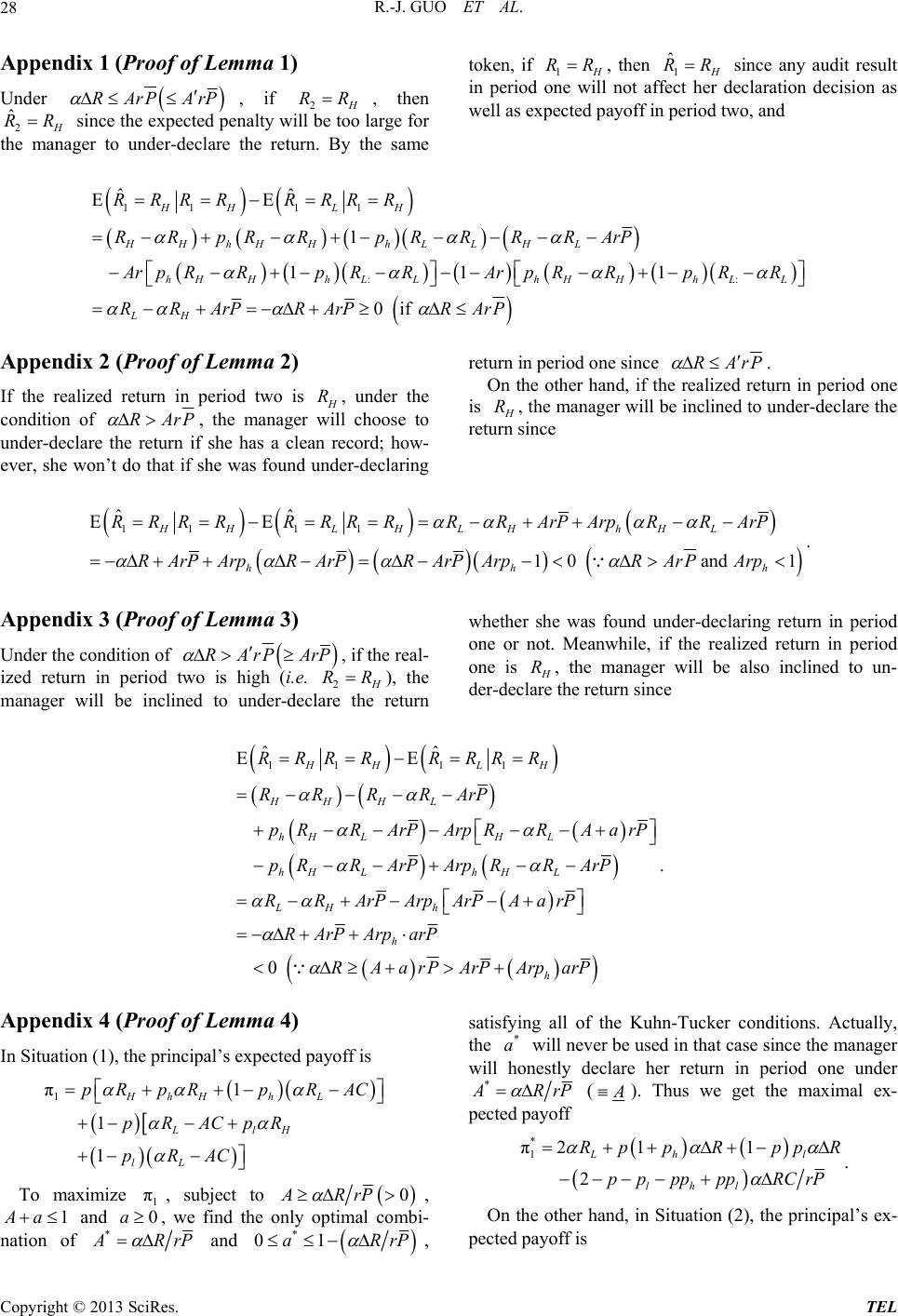 R.-J. GUO ET AL. 28 Appendix 1 (Proof of Lemma 1) Under RArPArP , if 2 RR, then 2 ˆ RR since the expected penalty will be too large for the manager to under-declare the return. By the same token, if 1 RR , then 1 ˆ RR since any audit result in period one will not affect her declaration decision as well as expected payoff in period two, and 11 11 : : ˆˆ 1 11 1 0if HH LH HHhHH hLLHL hHHhLL hHHhL LH RRRR RRRR RRpRR pRRRRArP Arp RRpRRArp RRpRR RRArPR ArPRArP L Appendix 2 (Proof of Lemma 2) If the realized return in period two is R, under the condition of RArP , the manager will choose to under-declare the return if she has a clean record; how- ever, she won’t do that if she was found under-declaring return in period one since RArP . On the other hand, if the realized return in period one is R, the manager will be inclined to under-declare the return since 11 11 ˆˆ 10and 1 HH LHLHhHL hh RRRRRRRRRRArPArp RRArP RArPArpRArPRArPArpRAr PArp h . Appendix 3 (Proof of Lemma 3) Under the condition of RArP ArP , if the real- ized return in period two is high (i.e. 2 RR), the manager will be inclined to under-declare the return whether she was found under-declaring return in period one or not. Meanwhile, if the realized return in period one is R, the manager will be also inclined to un- der-declare the return since 11 11 ˆˆ 0 HH LH HH HL hH LH L hH LhH L LH h h h RRRR RRRR RRRRArP pRR ArPArpRRAarP pRRArPArpR RArP RRArPArpArPAarP RArPArp arP RAar PArPArparP . Appendix 4 (Proof of Lemma 4) In Situation (1), the principal’s expected payoff is 1 π1 1 1 HhHh L LlH lL pRpRpR AC pRACpR pRAC To maximize , subject to 1 π 0ARrP , and a, we find the only optimal combi- nation of 1Aa 0 * RrP and * 01aR rP , satisfying all of the Kuhn-Tucker conditions. Actually, the will never be used in that case since the manager will honestly declare her return in period one under * a * RrP ( ). Thus we get the maximal ex- pected payoff * 121 1 2 Lh l lhl Rp pRppR ppppppRC rP π . On the other hand, in Situation (2), the principal’s ex- pected payoff is Copyright © 2013 SciRes. TEL 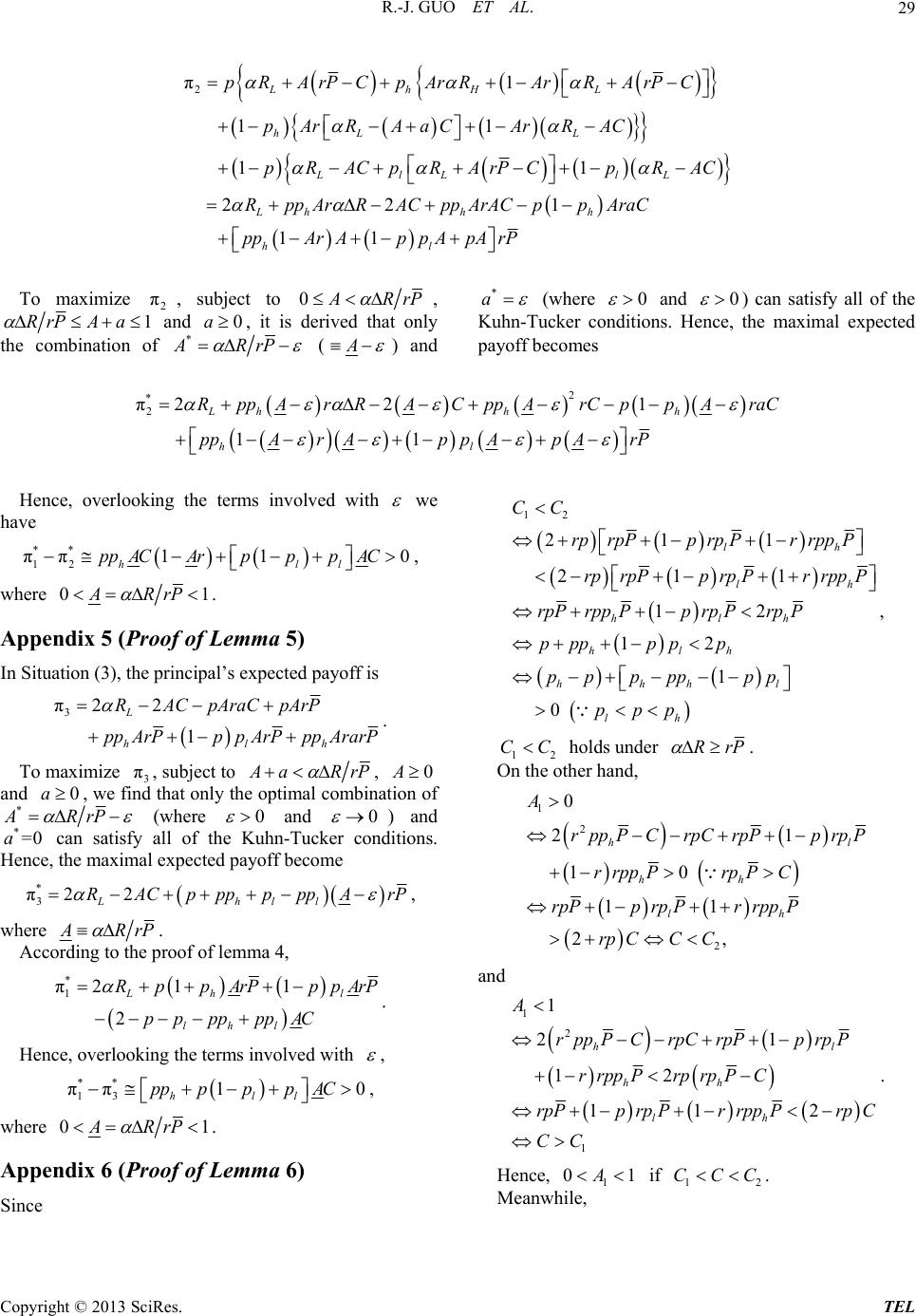 R.-J. GUO ET AL.29 2 π1 11 11 22 1 11 LhHL hL L LlL lL Lhh h hl pR ArPCpArRArR ArPC pArRAaCAr RAC pR ACpRArPCpRAC Rpp ArRACppArACppAraC ppArApp ApArP To maximize 2, subject to π0 RrP , 1RrPAa and , it is derived that only the combination of 0a * ARrP (A ) and * a (where 0 and 0 ) can satisfy all of the Kuhn-Tucker conditions. Hence, the maximal expected payoff becomes 2 * 2 π221 11 Lhh h hl RppA rRACppArCppA raC ppArAppApArP Hence, overlooking the terms involved with we have ** 12 ππ 11 hl pp ACArpppAC 0 l , where 01ARrP . Appendix 5 (Proof of Lemma 5) In Situation (3), the principal’s expected payoff is 3 π22 1 L hlh RACpAraCpArP ppArPpp ArPppArarP . To maximize 3, subject to π aRrP0A , and , we find that only the optimal combination of 0a *rARP (where 0 and 0 ) and can satisfy all of the Kuhn-Tucker conditions. Hence, the maximal expected payoff become *=0a * 3 π22 Lhll RACppppppAr P , where RrP . According to the proof of lemma 4, * 1 π21 1 2 Lhl lhl Rp pArPppArP pp ppppAC . Hence, overlooking the terms involved with , ** 13 ππ 10 hll pppppAC , where 01ARrP . Appendix 6 (Proof of Lemma 6) Since 12 211 211 12 12 1 0 lh lh hlh hlh hhh l lh CC rprpPprp PrrppP rprpPprp PrrppP rpPrpp PprpPrp P ppppp p pp ppppp ppp , 12 CC holds under RrP . On the other hand, 1 2 2 0 21 10 11 2, hl hh lh A rppPCrpCrpPprpP rrppPrpP C rpPprpPrrppP rp CCC and 1 2 1 1 21 12 112 hl hh lh A rppPCrpCrpPprpP rrppPrprpP C rpPprp PrrppPrpC CC . Hence, 1 01A if . 12 CCC Meanwhile, Copyright © 2013 SciRes. TEL 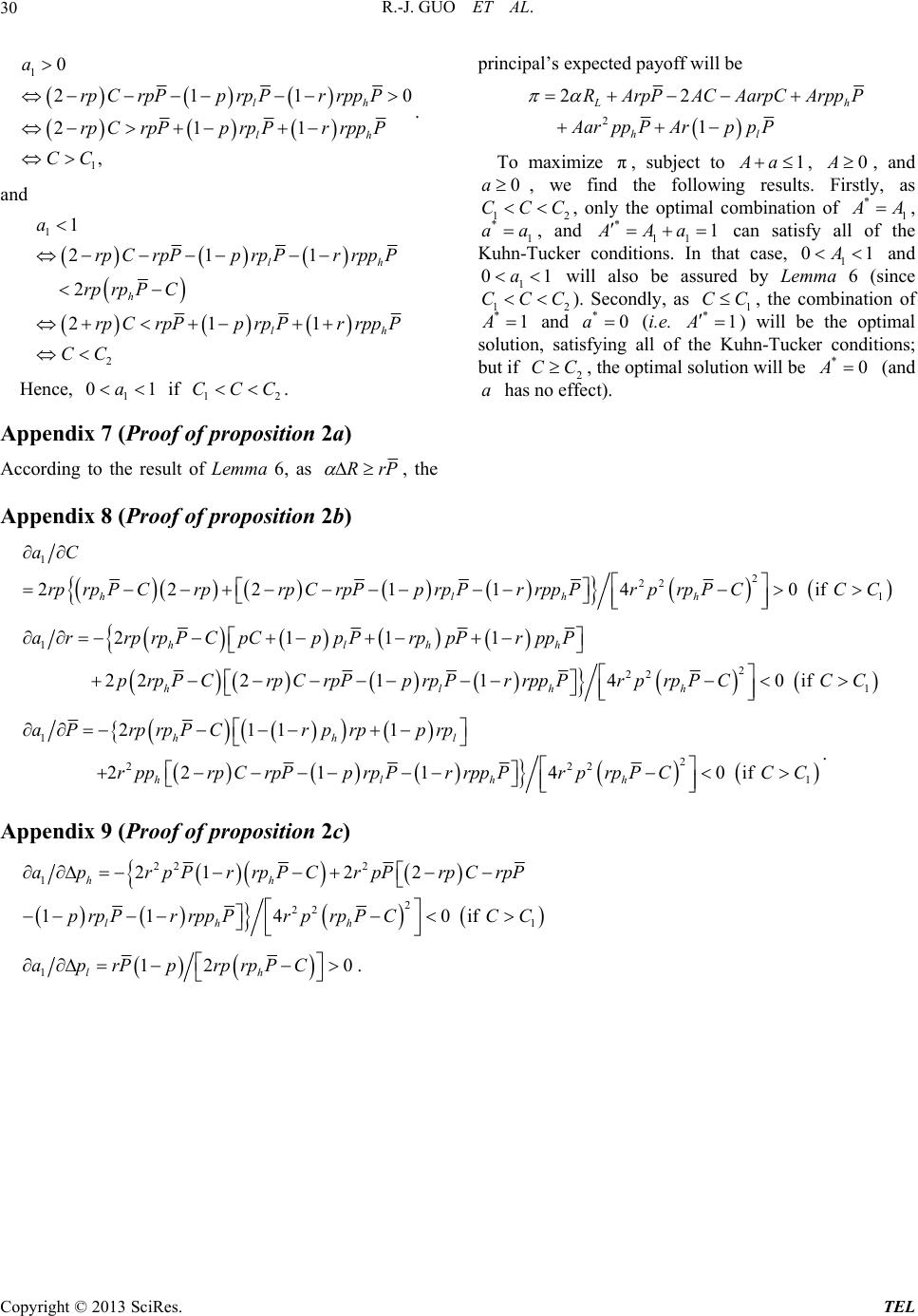 R.-J. GUO ET AL. 30 1 1 0 211 211 , lh lh a rpCrpPprp PrrppP rpCrpPprp PrrppP CC 0 . and 1 2 1 211 2 211 l h lh a rpCrpPprpPrrppP rprpPC rpCrpPprp PrrppP CC h Hence, if . 1 01a 12 CCC Appendix 7 (Proof of proposition 2a) According to the result of Lemma 6, as RrP , the principal’s expected payoff will be 2 22 1 Lh hl RArpPACAarpCArpp P AarppPArpp P To maximize , subject to , , and , we find the following results. Firstly, as 2 π1Aa 0A 0a 1 CCC , only the optimal combination of 1 * A , 1 * aa , and 11 * 1AAa can satisfy all of the Kuhn-Tucker conditions. In that case, and 1 0A1 1 0a1 C will also be assured by Lemma 6 (since 21 CC ). Secondly, as 1, the combination of CC *1 and *0a (i.e. *1 ) will be the optimal solution, satisfying all of the Kuhn-Tucker conditions; but if 2, the optimal solution will be CC*0A (and has no effect). a Appendix 8 (Proof of proposition 2b) 1 2 22 1 2221140if hlhh aC rprp PCrprpCrpPprpPrrpp Prprp PCCC 1 2 22 1 2111 22 21140if hlhh hlhh arrprpPCpCppPrppPrpp P prp PCrpCrpPprpPrrpp PrprpPCCC 1 2 222 1 2111 221 140if hhl hlhh aPrp rpPCrprpprp rpprpCrpPprpPrrpp Prprp PCCC . Appendix 9 (Proof of proposition 2c) 22 2 1 2 22 1 21 22 11 40if hh lh h aprpPrrp PCrpPrpCrpP prpPrrppPrprpP CCC 112 lh aprPprprpPC 0. Copyright © 2013 SciRes. TEL
|